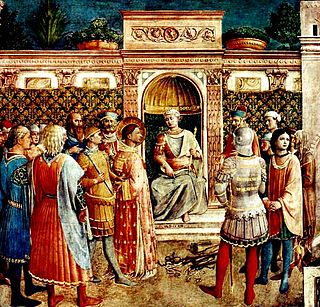
The 70s was a decade that ran from January 1, AD 70, to December 31, AD 79.

The 90s was a decade that ran from January 1, AD 90, to December 31, AD 99.

The 100s was a decade that ran from January 1, AD 100, to December 31, AD 109.
AD 7 was a common year starting on Saturday of the Julian calendar. In the Roman Empire, it was known as the Year of the Consulship of Metellus and Nerva. The denomination "AD 7" for this year has been used since the early medieval period, when the Anno Domini calendar era became the prevalent method in Europe for naming years.
AD 35 (XXXV) was a common year starting on Saturday of the Julian calendar. At the time, it was known as the Year of the Consulship of Gallus and Nonianus. The denomination AD 35 for this year has been used since the early medieval period, when the Anno Domini calendar era became the prevalent method in Europe for naming years.
AD 40 (XL) was a leap year starting on Friday of the Julian calendar. At the time, it was known as the Year of the Consulship of Augustus without colleague. The denomination AD 40 for this year has been used since the Early Middle Ages, when the Anno Domini calendar era became the prevalent method in Europe for naming years.
AD 65 (LXV) was a common year starting on Tuesday of the Julian calendar. At the time, it was known as the Year of the Consulship of Nerva and Vestinus. The denomination AD 65 for this year has been used since the early medieval period, when the Anno Domini calendar era became the prevalent method in Europe for naming years.
AD 91 (XCI) was a common year starting on Saturday of the Julian calendar. At the time, it was known as the Year of the Consulship of Glabrio and Traianus. The denomination AD 91 for this year has been used since the early medieval period, when the Anno Domini calendar era became the prevalent method in Europe for naming years.

100 (C) was a leap year starting on Wednesday of the Julian calendar, the 100th year of the Common Era (CE) and Anno Domini (AD) designations, the 100th year of the 1st millennium, the 100th and last year of the 1st century, and the 1st year of the 100s decade. As of the start of 100, the Gregorian calendar was 2 days behind the Julian calendar, which was the dominant calendar of the time.
The 170s decade ran from January 1, 170, to December 31, 179.
Year 162 (CLXII) was a common year starting on Thursday of the Julian calendar. In the Roman Empire, it was known as the Year of the Consulship of Rusticusand Plautius.
Year 170 (CLXX) was a common year starting on Sunday of the Julian calendar. At the time, it was known as the Year of the Consulship of Clarus and Cornelius. The denomination 170 for this year has been used since the early medieval period, when the Anno Domini calendar era became the prevalent method in Europe for naming years.
Year 4 BC was a common year starting on Tuesday or Wednesday of the Julian calendar and a common year starting on Monday of the Proleptic Julian calendar. At the time, it was known as the Year of the Consulship of Sabinus and Rufus. The denomination 4 BC for this year has been used since the early medieval period, when the Anno Domini calendar era became the prevalent method in Europe for naming years.

Publius Clodius Thrasea Paetus, Roman senator, who lived in the 1st century AD. Notable for his principled opposition to the emperor Nero and his interest in Stoicism, he was the husband of Arria, who was the daughter of A. Caecina Paetus and the elder Arria, father-in-law of Helvidius Priscus, and a friend and relative by marriage of the poet Persius. Thrasea was the most prominent member of the political faction known today as the Stoic Opposition.
Titus Avidius Quietus was a Roman senator active during the reigns of the emperors Domitian, Nerva and Trajan. The offices he held included suffect consul in AD 93 and governor of Roman Britain around 98.
Rusticus is a Latin adjective meaning "rural, simple, rough or clownish" and can refer to:

Quintus Junius Rusticus, was a Roman teacher and politician. He was probably a grandson of Arulenus Rusticus, who was a prominent member of the Stoic Opposition. He was a Stoic philosopher and was one of the teachers of the emperor Marcus Aurelius, whom Aurelius treated with the utmost respect and honour.
Quintus Junius Arulenus Rusticus was a Roman Senator and a friend and follower of Thrasea Paetus, and like him an ardent admirer of Stoic philosophy. Arulenus Rusticus attained a suffect consulship in the nundinium of September to December 92 with Gaius Julius Silanus as his colleague. He was one of a group of Stoics who opposed the perceived tyranny and autocratic tendencies of certain emperors, known today as the Stoic Opposition.
Herennius Senecio was among the Stoic Opposition to the emperor Domitian, under whose rule he was executed. He was from Baetica in Roman Spain. He was the author of a laudatory biography of the Stoic martyr Helvidius Priscus.

The Stoic Opposition is the name given to a group of Stoic philosophers who actively opposed the autocratic rule of certain emperors in the 1st-century, particularly Nero and Domitian. Most prominent among them was Thrasea Paetus, an influential Roman senator executed by Nero. They were held in high regard by the later Stoics Epictetus and Marcus Aurelius. Thrasea, Rubellius Plautus and Barea Soranus were reputedly students of the famous Stoic teacher Musonius Rufus and as all three were executed by Nero they became known collectively as the Stoic martyrs.





